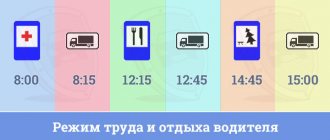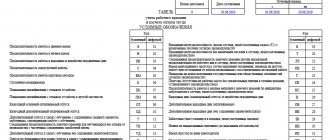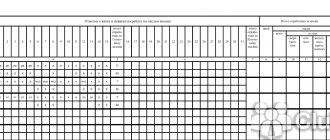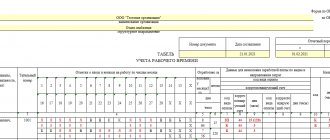What labor legislation standards should be followed when introducing and recording summarized working time recording?
How to keep summarized working time records correctly?
What nuances should you remember when calculating wages, paying overtime and holidays, and night shifts when using summarized accounting?
How to pay for a period not fully worked by an employee when accounting for working hours?
How to create a work schedule for an accounting period?
The specifics of the activities of some organizations are such that it is impossible to comply with the standard working hours per week. Most often, employees in such companies do not work five days a week, but go to work according to a schedule. The duration of their working day can be more than 8 hours, while in a week there are sometimes more than 40 hours of working time, sometimes less. In such a situation, the employer has the right to apply summarized recording of working time.
The rules for maintaining summarized records are not clearly stated in the legislation. Therefore, the management of the organization, the HR department and the accounting department have many questions about its application: which company regulations reflect the procedure for maintaining summarized accounting, whether this accounting needs to be entered for all company employees or for those who work according to a shift schedule, how to pay for overtime, weekends and night hours. We will try to answer them.
The rules for applying summarized working time recording are established in Art. 104 of the Labor Code of the Russian Federation (hereinafter referred to as the Labor Code of the Russian Federation).
For your information
Summarized recording of working time is introduced in those productions or when performing certain types of work when the norm of daily or weekly working hours cannot be met, for example, with a rotational work method (Article 300 of the Labor Code of the Russian Federation), flexible working hours (Article 102 Labor Code of the Russian Federation), work in shifts (Article 103 of the Labor Code of the Russian Federation).
The listed operating modes do not make it possible to maintain the established standard of weekly or daily work. For example, one week workers have overtime, and the next, on the contrary, they have free time.
With regular accounting of working hours, overtime must be paid as overtime at an increased rate. To avoid such situations, legislation allows the employer to use summarized recording of working hours. This means that the time worked is calculated not for a week, but for a different period of time (a month, three months, other periods). This period is called the accounting period.
The duration of working hours during the accounting period should not exceed the normal number of working hours. The accounting period should not exceed a year, and for recording the working time of workers engaged in work with harmful and (or) dangerous working conditions - three months, for drivers - 1 month.
The procedure for introducing summarized accounting
According to Art. 104 of the Labor Code of the Russian Federation, the procedure for introducing summarized recording of working time is established by the internal labor regulations (hereinafter referred to as PVTR).
The PVTR regulates the working hours, rest periods, incentive and penalty measures applied to employees, as well as other issues of regulating labor relations with a given employer.
Summarized recording of working time at an enterprise can be introduced by order (instruction) of the employer, taking into account the opinion of the elected body of the primary trade union organization (if the enterprise has a trade union).
Summarized working time tracking can be introduced throughout the organization or for specific employees. The condition of summarized accounting must be included in the employment contract.
According to Art. 74 of the Labor Code of the Russian Federation, if the terms of the employment contract determined by the parties, related to changes in organizational or technological working conditions, cannot be preserved, they can be changed at the initiative of the employer, with the exception of changes in the employee’s labor function.
That is, if the PVTR did not initially provide for summarized recording of working time, appropriate changes must be made when applying it.
How to make changes to PVTR
According to Part 1 of Art. 190 of the Labor Code of the Russian Federation PVTR are approved by the employer taking into account the opinion of the representative body of employees. Therefore, when making any changes to the PVTR, this procedure must be followed.
For your information
If the organization does not have a trade union, then employees at a general meeting (conference) can entrust the representation of their interests to a representative (representative body) elected from among the employees (Article 31 of the Labor Code of the Russian Federation).
Before making a decision to amend the PVTR, the employer must send a draft containing the main provisions regarding changes to the local regulatory act, accompanied by justifications to the representative (representative body). The representative, no later than five working days from the date of receipt of the draft PVTR, sends the employer a reasoned opinion on the draft in writing.
If the representative body or representative does not agree with the draft PVTR or proposals have been received to improve the project, the employer may agree with the representative’s opinion or disagree.
Within three days after receiving a reasoned opinion, the employer holds an additional meeting with a representative or representative body in order to reach agreement.
If the parties do not agree, a protocol of disagreement is drawn up. After this, the employer has the right to adopt a local regulation.
In turn, the representative body has the right to appeal the text of the rules approved by the employer in the state labor inspectorate or in court.
How to make changes to an employment contract
If before the introduction of summarized accounting, the employee was on a different regime, for example, a 5-day work week with two days off, then an additional agreement is drawn up to the employment contract, which reflects the conditions for the use of summarized recording of working time. In the section “Working hours” of the additional agreement to the employment contract, it is advisable to indicate the following points:
1. The employee is provided with a summarized recording of working time.
2. The procedure for introducing summarized recording of working time is established by the Internal Labor Regulations.
3. The accounting period is a month.
4. The standard working time for the accounting period is established based on a 40-hour work week with two days off.
5. The date and time the employee goes to work, the duration of work, the end time of work, and days off are determined in the work schedule.
6. Work schedules are brought to the attention of the employee no later than 1 month before they come into effect.
7. A break for rest and food (45 minutes) is provided every 4 hours of work.
8. The hourly rate for calculating wages for salaried employees is calculated by dividing the official salary by the average annual standard number of hours and remains unchanged during the current year.
Note!
The employer is obliged to notify employees of changes in the terms of the employment contract (in our case, the transition to summarized recording of working hours) in writing no later than 2 months in advance (Part 2 of Article 74 of the Labor Code of the Russian Federation) - for example, issue an order to amend the PVTR with employee list application.
If the employee refuses the working conditions in the new regime, i.e. in new organizational conditions, then the employment contract is terminated in accordance with clause 7, part 1, art. 77 Labor Code of the Russian Federation.
When switching to summarized recording of working hours, the employer is obliged to develop a work schedule that contains information about the standard working hours, the number of days off and working days, the boundaries and duration of the working day, as well as the combination of working periods with rest periods.
Number of hours with a shift schedule of 2 every 2
In most cases, with such a work schedule, an employee has 7-8 shifts in one calendar month. With a 40-hour work week, the total number of hours per month is about 160 hours. This is the normal figure, from which one hour should be subtracted for each Friday shortened day.
If we start from the most common cooperation schemes, then with a 2/2 shift schedule the duration of one shift is 10-12 hours. At the same time, we would like to remind you that the legislation does not regulate the duration of one work shift. It is established by the employer independently, based on normal, generally accepted standards.
As an example, you can take a 12-hour work schedule. Hence:
- If an employee works 15 days on average (7-8 shifts), then the total working hours in one month will be 180 hours (12*15).
- The normal working hours for a 40-hour workweek is 160 hours.
- It turns out that with a shift schedule, an employee overworks the norm by an average of 20 hours.
But such a scheme is not considered a violation on the part of the employer, since it is permissible to sum up the total number of hours during the reporting period. Such a reporting period can be a month, a quarter, or a year. It all depends on what type of work the employee performs and for how long the employment contract is concluded.
Registration of work schedules and time sheets for summarized accounting
The work schedule can be introduced by order of the head of the organization. The law does not establish a special procedure providing for the form and time frame for familiarizing employees with the work schedule. Therefore, the employer can independently determine the procedure for familiarizing himself with the work schedule, while providing for reasonable deadlines.
We remind you that the Labor Code of the Russian Federation generally defines normal working hours as a 40-hour working week (Article 90 of the Labor Code of the Russian Federation). The duration of work duties during the accounting period should be no more than a normal week, multiplied by the number of weeks in the accepted accounting period.
When drawing up a work schedule, the length of the accounting period is taken into account, which should not exceed a year.
Depending on the specifics of the company’s work, work schedules with different working hours and combinations of rest periods may be established for different positions.
As an example, consider the work modes of communication (railway) specialists (Table 1).
When drawing up a work schedule, the following are taken into account:
1. Standard working hours. The number of working hours according to the schedule for the accounting period should not be greater than the number of working hours according to the production calendar for the same period.
2. One shift cannot last longer than 12 hours.
3. It is prohibited to work two shifts in a row.
4. Weekly uninterrupted rest must be at least 42 hours.
5. Break for rest and food - from half an hour to two hours.
6. The duration of night shifts should be reduced by one hour without further work.
7. On the day before a holiday, the duration of the shift is reduced by 1 hour.
8. Annual leave of 28 calendar days is taken into account.
9. The work schedule should not contain conditions for overtime work.
To correctly draw up a work schedule, you first need to determine the number of people per workplace.
How many employees are needed per workplace can be calculated as follows:
(Number of calendar days in the accounting period) × (Duration of the working day in hours) / (Normal for the accounting period according to the production calendar - Number of working days coming for vacation).
Example 1
The trading organization's operating hours are from 10:00 to 20:00, seven days a week. Normal working hours are no more than 40 hours per week. The accounting period is quarter. It accounts for 480 hours (40 hours × 4 weeks × 3 months) of working time.
Vacation lasting 28 calendar days. It accounts for 160 working hours (4 weeks × 40 hours).
Let's determine how many employees are needed per workplace to avoid overtime:
90 days × 10 hours / (480 hours – 160 hours) = 2.8 people, i.e. 3 employees are needed for 1 workplace.
The employer is obliged to take into account the working time of employees personally, separately recording the actually worked hours of each person in the time sheet. The time sheet is compiled in one copy by an authorized employee and submitted to the accounting department. A completed and signed time sheet is the basis for settlements with employees and the calculation of wages for the time actually worked.
How are working hours determined?
In accordance with Articles 100 and 189 of the Labor Code of the Russian Federation, the working hours are established by the employer in agreement with the employee. The length of the working day is necessarily fixed in the employment contract.
At the same time, the normal working hours per week cannot exceed 40 hours (Article 91 of the Labor Code of the Russian Federation).
This number of hours is the most common standard for most positions. It turns out that the employee works 5 days a week for 8 hours.
For certain categories of citizens, as well as for some labor positions, a smaller number of working hours per week is established. For example, in hazardous industries they work on average 20-25 hours a week. The duration of one working day is not regulated by current labor legislation: in fact, it can be anything.
Payment for night hours with total accounting
Night hours (from 22:00 to 6:00) must be taken into account separately and paid at an increased rate (Article 154 of the Labor Code of the Russian Federation). The minimum bonus for night work is 20% of the hourly tariff rate (official salary), calculated for each hour of night work.
The number of night hours worked is determined by the working time sheet (form T-12 or T-13). To reflect the hours worked at night on the timesheet, use the letter code “H” or the numeric “02” indicating the number of hours worked at night.
Example 4
The company has established a summarized recording of working hours for all employees. The billing period is one month. The working hours for individual employees (security guards, dispatchers, storekeepers) are every three days.
The working time sheet for April is presented in table. 4.
Let's calculate the salary of dispatcher V. G. Sokolov for April according to the work time sheet.
From the timesheet data it follows that in April the dispatcher worked 7 shifts of 24 hours each. The total time was 168 hours (7 shifts × 24 hours), including 56 hours of night work.
Work within normal limits. We pay extra for night work.
The hourly tariff rate for this specialist is 300 rubles. Night time surcharge - 20% of the hourly tariff rate.
Wages for April will be equal to:
168 hours × 300 rub. + (56 hours × 300 rub. × 20%) = 53,760 rub.
For your information
If during the accounting period both overtime and night work took place, then both overtime work and night hours are subject to payment at an increased rate, since this work is performed under conditions deviating from normal ones.
Payment for holidays with total accounting
According to Art. 153 of the Labor Code of the Russian Federation, work on a day off or a non-working holiday is paid at least double the amount.
Note!
When accounting for working hours in total, work on weekends and holidays is included in the monthly working time standard.
In order to correctly process wages on holidays and weekends, you need to determine whether the holiday is a working day according to the employee’s schedule or whether he should rest on this day. If this is a scheduled working day for an employee and he worked this day, as indicated by the mark “I” on the time sheet, then the additional payment for this day should be made in a single amount, since there are no special deviations for summarized accounting in Art. 153 of the Labor Code of the Russian Federation no.
That is, an employee, subject to a full work schedule, will receive wages calculated based on the hourly tariff rate or salary and an additional payment in the amount of a single rate for a holiday.
If a holiday is not a working day according to the schedule, but it is reflected in the timesheet as “RV” - the duration of work on weekends and non-working days, then the additional payment for this day should be made in double the amount in the current month.
In this case, the employee will receive wages calculated at the salary or hourly rate, and an additional payment in the amount of double the rate for a holiday.
Note!
When calculating overtime hours at the end of the accounting period, work performed on holidays in excess of the norm should not be taken into account, since it has already been paid in double amount (clause 4 of Explanation No. 13/P-21 “On compensation for work on holidays”).
What types of driver rest are there?
| Type of holiday | Duration |
| Break for rest and food during the working day | From 30 minutes to 2 hours. |
| Daily (between shifts) rest | At least 2 times longer than a work shift. In exceptional cases - at least 9 hours. |
| Weekends (weekly uninterrupted rest) | The total duration is at least 45 hours. |
| Annual leave | Minimum 28 calendar days. |
Let's look at each of them in more detail.
Breaks for rest and food
The break can range from 30 minutes to 2 hours. If a working day (shift) lasts more than 8 hours, then there can be two breaks, but their total duration should also not be less than half an hour or exceed 2 hours. Specific values are established by the employer in a local act.
Daily (between shifts) rest
The duration of such rest, if added to a break for rest and food, should be at least 2 times longer than the working day (shift) preceding it. For example, after an 8-hour work shift with a 1-hour rest break, the driver must rest for at least 15 hours before starting the next one. If the break was 2 hours, then before the next shift he must rest for at least 14 hours
When calculating working hours in total, daily rest should not be shorter than 11 hours. But you can:
- Reduce daily rest to 9 hours no more than three times during the period between the end of one weekly rest and the beginning of the next.
- Divide your vacation into several parts. The first must be at least 3 hours, the last - at least 9.
If there are several drivers in the crew, they are obliged to simultaneously and fully use the daily rest of at least 9 hours.
After Order 424 comes into force, any daily rest can be replaced with a weekly rest - weekends. Previously, it was necessary to first organize daily and then weekly rest for the driver.
Break between shift parts
With the consent of the drivers, shifts can be divided into parts. There must be breaks between parts of the shift - no later than five hours after the start of work. The total time of breaks should not exceed:
- 3 hours - for drivers who carry out regular suburban and urban transportation;
- 5 hours - for other drivers.
Weekly uninterrupted rest (weekends)
The total duration of a driver's weekly uninterrupted rest should not be less than 45 hours.
You can reduce your weekly rest to 24 hours no more than once in two calendar weeks. The driver can take the rest of the time off over the next three calendar weeks.
If there are several drivers in the crew, their weekly rest can be reduced to 24 hours each week if they rest the remaining hours over the next three weeks.
Drivers may, with their consent, be hired to work on non-working holidays if the specifics of their work are related to:
- activities, the suspension of which is impossible due to production and technical conditions;
- public service;
- repair and loading and unloading operations.
Other cases and conditions for attracting employees to work on weekends and holidays are described in Article 113 of the Labor Code of the Russian Federation.
Annual leave
Drivers, like employees of other professions, are provided with an annual basic paid leave of 28 calendar days.
For drivers with irregular working hours, additional paid leave is provided for a period of at least 3 days. Its specific duration is determined by the regulatory documents of the organization, PVTR or collective agreement.
Harmful or dangerous working conditions are also subject to additional leave of at least 7 days. Work is recognized as dangerous or harmful based on the results of a special inspection. In any case, this must be specified in the employment contract.
In addition to rest periods, drivers have special breaks.
You can continuously drive a vehicle for no more than 4.5 hours. Afterwards, the driver must take a break for at least 45 minutes. The break can be divided into several parts. In this case, the first part of the rest should last at least 15 minutes, and the last - immediately before returning to the wheel - at least 30 minutes. The continuous driving time can be exceeded by a maximum of an hour if the driver is moving to a rest area or to a final destination.
Fines for legal entities
Check










